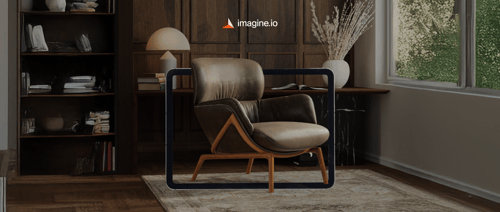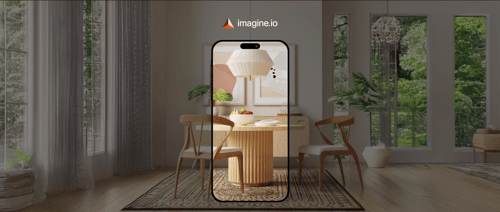How Amazon Rufus Uses Image Recognition to Enhance Product Discovery
In the world of online retail, the line between text and visuals is blurring faster than ever. The traditional way of browsing through static product listings is giving way to a more intuitive, visual-first experience—driven by AI.
Enter Amazon Rufus.
If you're a brand selling online, Rufus isn’t just another feature update. It’s a shift in how consumers interact with your products. And at the center of this shift is image recognition. Let’s unpack how Rufus is shaping the future of product discovery—and what that means for your eCommerce strategy.
Get the latest updates straight to your inbox.
By clicking sign up you'll receive occasional emails from imagine.io. You always have the choice to unsubscribe within every email you receive.
What is Amazon Rufus and How Does it Work with Imagery?

Amazon Rufus is Amazon’s new AI-powered shopping assistant designed to make product search more conversational and intuitive. But beyond its natural language capabilities, what’s truly game-changing is how it sees.
Rufus incorporates image recognition, using vision-language models and Optical Character Recognition (OCR) to understand the content, context, and meaning of visuals. This means it doesn't just read what’s written—it analyzes what’s shown.
Image Recognition: The Power Behind the Vision
Here’s what makes Rufus’s image recognition so powerful:
- OCR (Optical Character Recognition) allows Rufus to extract and interpret text from within images—think ingredients, product specs, or certifications displayed on labels.
- Vision-language models interpret images holistically. It’s not just about reading the text on a package—it’s about understanding what that image means in the context of a shopping query.
Real-World Application: Visual Product Queries in Action
Imagine a shopper clicking on a product image that includes a step-by-step usage infographic. Rufus can analyze that visual, interpret each step, and enhance the shopper's understanding—without them needing to read long product descriptions.
Here’s another example based on a user input- imagine a customer taking a picture of a stylish blender on a friend’s kitchen counter. They upload it to Amazon. Rufus:
- Identifies the model and brand using image recognition.
- Matches it with Amazon’s product catalog.
- Recommends alternatives—possibly newer, more advanced models based on their preferences.
No typing. No guesswork. Just point, snap, and shop.
This functionality dramatically reduces friction in product discovery and aligns perfectly with how modern consumers engage—visually.
How Amazon Rufus Understands Images
Amazon Rufus uses a combination of image recognition, optical character recognition (OCR), and vision-language models to interpret and evaluate product visuals. These technologies work together to help Rufus understand what a product is, assess its relevance, and surface it in the right contexts.
This makes high-quality visuals—such as size charts, lifestyle imagery, A+ content, videos, and even 3D models (where supported)—more important than ever. Not only do they improve the customer’s shopping experience, but they also provide Rufus with richer data to deliver more accurate recommendations and improve discoverability.
How Does Rufus Interpret Imagery and Text?

Rufus combines advanced image recognition, optical character recognition (OCR), and vision-language models to analyze both visual and textual content across product listings. This enables it to "see" and "read" key elements such as size charts, labels, lifestyle photos, and A+ content.
For example, Rufus can extract text from infographics or packaging using OCR and correlate it with product features. It can also interpret visual cues—like scale, use-case scenarios, and product variations—to better understand what’s being sold and how it might meet a shopper’s needs.
The result: more accurate search results, smarter recommendations, and better content relevance. High-quality visuals aren’t just helpful for customers—they're critical inputs for Rufus to fully comprehend and surface the right products.
What This Means for Brands
If you’re in upper management, the strategic implications are clear: investing in smart visuals isn’t just about design—it’s about being discoverable, understandable, and buyable in a visual commerce landscape.
Here’s how to make the most of Rufus’s image recognition capabilities:
1. Curate a Diverse Set of High-Quality Images
Rufus evaluates the entire image gallery, not just the main image. Ensure your product listing includes a well-rounded set of visuals that collectively tell a complete product story:
- Main Image: Clear, clutter-free, and true-to-scale.
- Close-Ups: Highlight texture, stitching, buttons, zippers, seams—details that shoppers care about.
- Contextual Shots: Show the product in real-life settings. For example, display a lamp in a styled room or a rug beneath furniture.
- Exploded or Variant Views: If supported, include 3D models or exploded views to communicate product structure or customization.
Each image should provide new information to avoid redundancy and ensure maximum informational value per visual.
2. Use Text Overlays Strategically
With Rufus’s OCR capabilities, text embedded in images is no longer ignored. You can now:
- Add short, descriptive overlays (e.g., “Anti-Slip Base,” “100% Cotton”) to call out features.
- Ensure text is legible across mobile and desktop formats—avoid script fonts or poor contrast.
- Highlight benefits rather than just features. For instance, “Machine Washable – Easy to Clean” adds practical context.
Avoid overloading your images—clarity and simplicity make a stronger impact.
3. Align Visuals with Written Content
Rufus interprets images in tandem with text. Consistency across titles, bullet points, and backend attributes is key:
- Match visual elements to descriptive language (e.g., a close-up of tufted fabric should correspond with the phrase “tufted, velvet surface”).
- Use rich, descriptive noun phrases that complement what’s visible (e.g., “coastal-inspired blue area rug with braided edges”).
This alignment helps Rufus generate more accurate, relevant responses during user queries.
4. Design for Multi-Image Interpretation (MIVC)
MIVC enables Rufus to combine information from all images to build a unified product representation. To take advantage of this:
- Vary image types and angles—don’t repeat the same view.
- Show different use cases or settings for your product (e.g., a sofa in small and large rooms, folded and expanded states).
- Include detailed feature-specific images that may become the focus of attention depending on customer queries.
Each image should answer a different potential question about the product.
5. Optimize for AI Rendering in Chat
Rufus can now surface and render the most relevant product image based on customer queries in real time. To make your images chat-friendly:
- Ensure your most informative images are early in the sequence (they may be prioritized).
- Include visuals that directly address common shopper questions—like size, material, portability, or ease of use.
- Add images that combine text and visuals to help Rufus quickly interpret and respond with confidence.
6. Monitor and Adapt Based on Customer Q&A
Pay close attention to questions shoppers ask. Are they asking about features you haven’t clearly shown? Use this insight to update your image gallery.
- Add visuals that directly respond to FAQs (e.g., “What’s the thickness of this rug?” → include a side profile image).
- Consider turning common Q&As into annotated images with simple callouts.
Visual Commerce Meets Automation

At imagine.io, we understand the power of visuals in product storytelling. Our platform lets brands:
- Create photorealistic 3D product visuals—no photoshoots required.
- Build dynamic infographics and lifestyle renders.
- Automate content for different platforms while maintaining quality and compliance.
And yes, it integrates seamlessly with image-first commerce platforms.
When tools like Rufus lead the charge, brands that invest in high-quality, AI-readable visuals will have the edge. That’s where visual commerce meets performance—and automation becomes a competitive advantage.
Final Thoughts
Amazon Rufus is changing how product discovery happens. And as visual commerce gains traction, sellers must be proactive—not reactive. Strong visuals aren’t optional anymore—they’re strategic assets.
It’s time to rethink your product content strategy. If Rufus is the future of AI shopping, your visuals are the front door.
With platforms like imagine.io, brands don’t have to scramble to keep up. You can scale high-quality, AI-optimized content with speed and consistency—without needing a design team for every new SKU.
Ready to future-proof your visual strategy? Book a free demo with imagine.io and discover how to streamline visual content creation for platforms like Amazon, Walmart, and Target.
.png?width=1440&name=How%20Amazon%20Rufus%20Uses%20Image%20Recognition%20to%20Enhance%20Product%20Discovery%20(1).png)

.gif?width=1296&height=1296&name=Untitled%20design%20(8).gif)




.png?width=500&name=How%20to%20Add%20a%203D%20Product%20Configurator%20to%20Your%20WordPress%20Website%20(Complete%20B2B%20Guide).png)
















%20(1).png?width=500&name=Why%20Exploded%20Mattress%20Views%20Matter%20(And%20How%20to%20Generate%20Them)%20(1).png)
.png?width=500&name=Best%20Shopify%20Product%20Configurator_%20How%20to%20Choose%20the%20Right%20One%20(2).png)
.png?width=500&name=Why%20Exploded%20Mattress%20Views%20Matter%20(And%20How%20to%20Generate%20Them).png)



.png?width=500&name=Best%20Shopify%20Product%20Configurator_%20How%20to%20Choose%20the%20Right%20One%20(1).png)







.png?width=500&name=How%203D%20Rendering%20Can%20Make%20or%20Break%20Your%20Industrial%20Design%20Pitch%20(1).png)








%20with%20Digital%20Twins%20and%203D%20Visualization.png?width=500&name=Optimizing%20Your%20Digital%20Asset%20Management%20(DAM)%20with%20Digital%20Twins%20and%203D%20Visualization.png)




.png?width=500&name=Styling%20Home%20Decor%20for%202025_%20From%20Global%20Influences%20to%20Playful%20Personalization%20(1).png)
